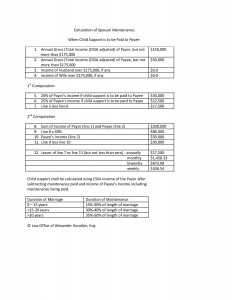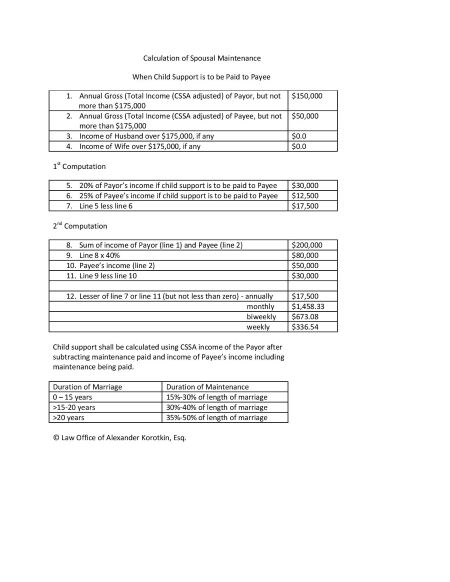On June 24, 2015, the New York State Senate passed Bill A7645-2015 which modified the duration and amount of temporary and post-divorce spousal maintenance. The bill passed the State Assembly on June 15th. It is expected to be signed by Governor Cuomo in the near future.
The new law’s formulas apply to actions commenced on or after the 120th day after the bill become law (except for the temporary maintenance formulas which apply to actions commenced on or after the 30th day after the bill become law). The new law can not be used as a basis to change existing orders and agreements.
The new law represents a very significant change to the post-divorce spousal maintenance provisions of Domestic Relations Law §236, as well as temporary spousal maintenance provisions that were passed in 2010.
As to maintenance, the following are the key aspects of the law contained in the Sponsor’s Memo:
The “cap” on the payor’s income used for the maintenance formula is $175,000, above which will be a matter of the court’s discretion. This reduces the cap (which now applies only to temporary pendente lite maintenance) from $543,000. The same $175,000 cap applies to post-divorce maintenance awards.
The statutes creates two formulas: one where child support will be paid to the maintenance recipient; and one where child support will not be paid, or where it will be paid to the maintenance payor. Those formulas are as follows: a. With child support where the maintenance payor is also the non-custodial parent for child support purposes: (i) subtract 25% of the maintenance payee’s income from 20% of the maintenance payor’s income; (ii) multiply the sum of the maintenance payor’s income and the maintenance payee’s income by 40% and subtract the maintenance payee’s income from the result; (iii) the lower of the two amounts will be the guideline amount of maintenance; maintenance payor is the custodial parent for child support purposes: (i) subtract 20% of the maintenance payee’s income from 30% of the maintenance payor’s income; (ii) multiply the sum of the maintenance payor’s income and the maintenance payee’s income by 40% and subtract the maintenance payee’s income from the result; (iii) the lower of the two amounts will be the guideline amount of maintenance.
First, maintenance gets calculated. Next, child support is calculated using the income of the payor after subtracting maintenance to be paid, and the income of payee income, including maintenance received.
The court may adjust the guideline amount of maintenance up to the cap where it finds that the guideline amount of maintenance is unjust or inappropriate after consideration of one or more factors, which are to be set forth in the court’s written or on the record decision. Where there is income in excess of the cap, additional maintenance may be awarded after consideration of one or more factors, which are to be set forth in the court’s decision or on the record.
When determining temporary maintenance, the court can allocate between the parties the responsibility for payment of family expenses” while the divorce action is pending. The definition of income for post-divorce maintenance will include income from income-producing property that is being equitably distributed. New factors in post-divorce maintenance will include: termination of child support, income or imputed income on assets being equitably distributed, etc. The duration of post-divorce maintenance is a function of a formula that includes ranges of different percentages of the marriage length, depending on how long the marriage lasted. For marriages of zero to 15 years, the guideline for maintenance awarded would be 15% to 30% of the length of the marriage; for marriages of more than 15 up to 20 years, maintenance would be 30% to 40% of the length of the marriage; for marriages of more than 20 years, maintenance would be for 35% to 50% of the length of the marriage. However, nothing prevents the court from awarding non-durational, post-divorce maintenance in an appropriate case.
In determining the duration of maintenance, the court is required to consider anticipated retirement assets, benefits and retirement eligibility age. Actual or partial retirement will be a ground for modification of post-divorce maintenance assuming it results in a substantial diminution of income.
As an example of the application of the formulas, consider the following calculations where a) the payor is the non-custodial parent and having C.S.S.A.-adjusted income of $150,000, and the payee is a custodial parent having C.S.S.A.-adjusted income of $50,000; and b) the payor and payee have the same incomes but there are no children being supported.


Additionally, the new law eliminates value of a spouse’s enhanced earning capacity arising from a license, degree, celebrity goodwill, or career enhancement as a marital asset. This is a significant change from the existing law. However, enhanced earnings may still be considered by the court when distributing other marital assets.
The changes to the Domestic Relations Law, once effective, will likely result in greater uniformity of spousal support awards. Further, elimination of enhanced earnings as a distributable asset represent a significant change in New York’s law.

